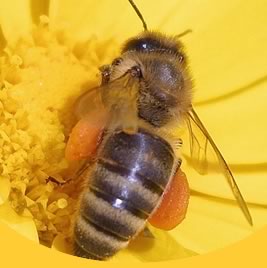

![]()
![]()
As beekeepers we bring the frames full of honey in
from the hive, ‘spin’ the honey out, settle it
and jar it.
We don’t
over-heat the honey. And we
don’t blend honeys
together
so it doesn’t destroy
its goodness
and flavour.
|
Q: What is
candied honey ? Chemically,
honey is a
solution of
sugars, minerals, acids and proteins
dissolved
in water. The
sugars
account for around
80% of the honey
while
water
only
makes up
around
17%.
Since
there is a high
content of
sugars
relative
to water, the
sugars
can't
remain
dissolved
in the
honey
and
it is
common
for
them
(mainly
glucose) to
form
crystals.
When
this
happens
the
honey is
said to
be
'candied.' Q: When honey crystallises does that mean it’s off? No. In fact it’s a good sign because it’s a sign of
the
honey’s naturalness
and wholesomeness.
It’s
simply some
of the
natural “bits” that
make
up honey, including
specks
of pollen,
binding
together.
All
honeys
candy but
just
not
in the
same
timeframe because
their
composition is
different
based on
the
flowering
plant they
come
from.
For example,
yellow box honey is
very
slow to
candy (say
a
couple
of years)
while
some
honey types
can
candy
overnight.
We knew
a
bloke who extracted
napunyah honey one day and
didn’t
clear out the
pipes from his extractor
to his settling tank.
He
came
back
the next
day
only to
find
his
pipes
full of rock
solid
honey.
Not a job
you’d want clearing that
up! We’re always getting asked about the practice of
beekeeping.
Understandably if you’ve not done
it and you
don’t know
any beekeepers, you
wouldn’t know this stuff. Q: Where do you keep your hives? There isn’t one place as such that we keep our hives.
Beekeeping
isn’t like
other forms of farming,
like, dairy or pig
farming
where your stock
is
kept
on your farm. We
have to move our
hives
all
around the
place to
place them where trees
are
flowering.
This is what
produces
the
nectar
that the bees
collect and bring
back to the hives
to
transform into
honey.
Our aim is to
place
hives where
there
is a
“honey
flow” and
only
leave them
there as
long
as
the flow
continues.
Once
a flow
dries
up we need
to
move
them
along to the next
place
and
the next
honey
flow. In a way they do, because we know that a bee won’t fly
past
a
good
flowering
tree to
go and
find
honey
elsewhere. If we
locate the
hives
amongst
a field of
flowering
canola, for
example, or blossoming
coolibah
trees,
the bees
will
automatically go
to
those plants to
collect
nectar. So our
job
is to
really
know
our trees and
flowers,
understand
their
flowering patterns
and be in
the
right
place
at the
right
time. Q: How many hives do you have? It varies from beekeeper to beekeeper and also from year to year. We will tend to “downsize” the number of hives during a bad season just because the conditions are such that the hives don’t flourish and keep re-building themselves as easily. But roughly in a reasonably good year we all have in the range of 800 hives. In each hive there’s about 60,000 bees so we like to say that means we have a workforce of millions so we can’t possibly know them all by name! Q: Why do you have to travel around so much? We have to move the bees where the nectar is and that depends on trees and flowers being in blossom. It’s not uncommon for us to do more than 100,000kms a year going in search of good country and moving bees around the place. Usually when we take bees to a site, we’d leave them there for about 6 weeks but if a honey flow dries up and the trees stop flowering, which can sometimes happen in a matter of days, then we have to move them again. Q: How do you get the bees not to fly away when they’re on the truck? Basically we wait until it’s dark before we travel. That allows for the field bees who’ve been foraging throughout the day to come home to the hive as night falls. Bees have an amazingly strong homing device – they’ll always come back to their particular hive, not even the one right next to it, only inches away. If you move the hive they get confused and flustered for a while until they find where you’ve moved it to. But once they’ve settled into the hives at night, they won’t come out again, so that’s when we pick them up and load them on the truck. Sometimes if we do it before they’re all back and inside , we’ll get huge “beards” of bees clinging to the outside of the hive boxes and even the truck itself. Each beekeeper tends to have different sites even
though they might
live
and be based in the
same
area, though
often we
might “lend” someone
a
site. On
average we’d
have about
250
sites.
You can’t
rely on the
same sites being
in
flower from season to
season. Several
years
might go
past when
a
site is no
good at all
and then
one year
it’ll
fire up.
We’ve developed
relationships with
landowners
over
the
years
whose places
we
put bees on usually for
about
30kg of
honey a
year in
return. Mostly
we go
on
private
land
though some
of
our sites
are
government
owned
and we
pay fees
for
those.
Farmers
like
having us
there
because bees are
good
pollinators
so it
can
help their
crops. And
they
like
knowing
that a
honey has come off
their land as
well. Q: Are all the bees in the hive the same? Definitely not. Some say that bees have developed the
perfect society
where
the workers (who are
sexually undeveloped
females) do all
the
work.
Another take
on it is
that the drones
are
typical males – fat
and lazy who are
good
for
only one thing!
Others would
prefer to
be
the Queen –
she gets
to mate
with the drones
of her choosing,
then
kill them
but she
then
spends the
rest of
her life laying
eggs. The bee hive is divided into different types of bees –
the
queen,
[link
back to
section
above where
it talks
about the queen]
the
workers
[link
back
to section above
where
it talks about the
workers] and the
drones
[link back to
section above where
it
talks about the
drones]. Q: If the bees do all the work, what do you actually have to do? Our work follows a seasonal pattern. The busiest time
by far is
from Spring
through to Autumn when
the trees are in
blossom
and
the bees’ honey
production is at
its peak. During this
time
our focus is
on
ensuring
the hives are
in
the best place possible to
capture available
honey
flows so a lot of
our
time is taken
scouring
the countryside for
flowering
plants
and
moving bees
back and
forward. Q: How do you get the honey out of the frames? We bring the boxes full of honey back to our
extracting plants.
There
are
different
types
of
extractors but
the
more
common ones
work
using
centrifugal force.
First each
frame
has
to
be “uncapped”
which
means slicing off
the
wax that the bees have used to seal in the
honey.
We used to do
this by hand with hot
knives but now the
frames go through
an
automated
uncapper. From
there
they are
hung in
racks
in the
extractor
(usually a
stainless
steel covered
container that
rotates
at high speed)
and
effectively
“spun”
so
that all the
honey
comes
flying
out and
drains
into a sump and
then is
piped
along to a
settling tank
before
passing
through to
the
filling
stage. Q: What’s the best type of honey? There’s no such thing as “the best” type of honey.
It comes down to personal preference
just like you might prefer different
wine
varieties
– for
example,
chardonnay to
riesling or
pinot
noir to shiraz.
Having
said that, there
are
types of
honey
that
are
generally regarded
as
better tasting and more
popular as a result
and
there are some that because they pick up
the
characteristics of
the
plant don’t taste
quite so good. These are
very rare though -
we’re
lucky in
Australia to have such good honeys as
the norm,
mainly from
different types of
eucalypts
and
other
native
flora. Some
of
the
best-tasting,
most
popular honey types
include: Q: Do you eat a lot of honey yourselves?
Absolutely! The Sunderland
household, for example, goes through
about a
kilo a
week. Of course we use it for more than just
spreading
on
toast.
Honey is
incredibly versatile and we use it in
cooking a
lot. We
always
use it in
tea instead
of
sugar not
just
because
it tastes
good
but also
because you
need less for
the same
sweetness.
Honey
has
always been
recognised
through history as
being
good for
you
and
containing
lots
of
essential vitamins
and minerals - we also
take
a spoonful
each night
before going to bed
because we find it
makes us sleep
better. Q: How often do you get stung? And does it hurt? Of course if we had a dollar for every time we’re
asked this
question we
wouldn’t have to sell
any more honey. We could
all
retire and
keep
bees. Q: How long has honey been around? Instead of dirt and poison we have rather chosen to fill our hives with honey and wax; thus furnishing mankind with the two noblest of things, which are sweetness and light. Jonathon
Swift Honey through history and across the globe |
